The Improved Outboard Well
Replacing an inboard engine with a tilt-up
outboard in a custom-built well

Atom’s extra-long-shaft outboard motor places the shaft nearly as low as the original prop in its aperture.
My 28-foot Pearson Triton, Atom, has undergone several extensive refits during our 40 years and two circumnavigations together. One of her major transformations included going from an inboard engine to an outboard motor well. Originally, she was equipped with a finicky Atomic 4 gasoline inboard that so disliked the salty marine environment and my inept care that it too often refused to do its job. I lived for several years with oil dripping into the bilge and the ever-present scent of gasoline permeating the cabin. The final insult came when it spit fire in my face as I knelt before its backfiring carburetor. I stubbornly refused to become a proficient mechanic, and the mulish engine made it obvious that it would accept nothing less. Being a committed engine-hater, our breakup was inevitable. My extremely limited budget at the time and my unwillingness to continue sharing my living space with any engine meant that upgrading to a more reliable diesel inboard was unthinkable. I’m glad now that my earlier poverty prevented me from making the common choice of converting to an inboard diesel because I would have remained ignorant of an auxiliary power solution that, as it turned out, better suited my needs.
After my first circumnavigation in the 1980s, I felt I had the seamanship skills needed for the challenge of sailing engineless, so I removed the burdensome beast and sailed across the Caribbean and Pacific in the rewarding pursuit of purely sail-powered passage making. Despite the successful engineless passages I made as I lived the romance of an earlier age of seafaring, I came to understand the very real limitations of engine-free pure sailing, one of which was that there were many ports that I could not safely enter or exit under sail or sculling oar alone. After a near shipwreck on a wave-lashed rocky coast when I was suddenly becalmed and then a terrifyingly close encounter with a tug and barge when becalmed one night in the Sulu Sea, I knew that the long odds of this high-risk game could catch up to me one day.
Eventually, I decided on a compromise solution by hanging a 3 hp outboard motor on an adjustable transom bracket. With the engineless sailing skills I now possessed, I used the motor sparingly, which was just as well because its limited power could only move my four-ton boat against the lightest winds and currents, and its short shaft meant the prop sucked air in even slight waves. Towards the end of my second circumnavigation, I began thinking of placing a larger motor within a well in the lazarette locker. The problem was that a larger motor just would not fit within the tight confines of the Triton’s pinched lazarette. For a few years, the optimal solution eluded me.
Years later, back in the US, I upgraded Atom with a 6 hp 4-stroke, 20-inch long shaft motor, which I used on a custom transom bracket on twin vertical tracks that permitted the motor to lift 18 inches for storage at sea. That setup gave me adequate power to stem the currents of the Intracoastal Waterway and ocean inlets, but steering the boat was awkward as I reached over the transom to operate the shifter and throttle. In its titled-up stored position it was also unsightly and placed the motor’s weight higher and farther aft than ideal for optimal sailing performance. A better solution would come a few years later as I experimented with different outboard well designs on a variety of boats.
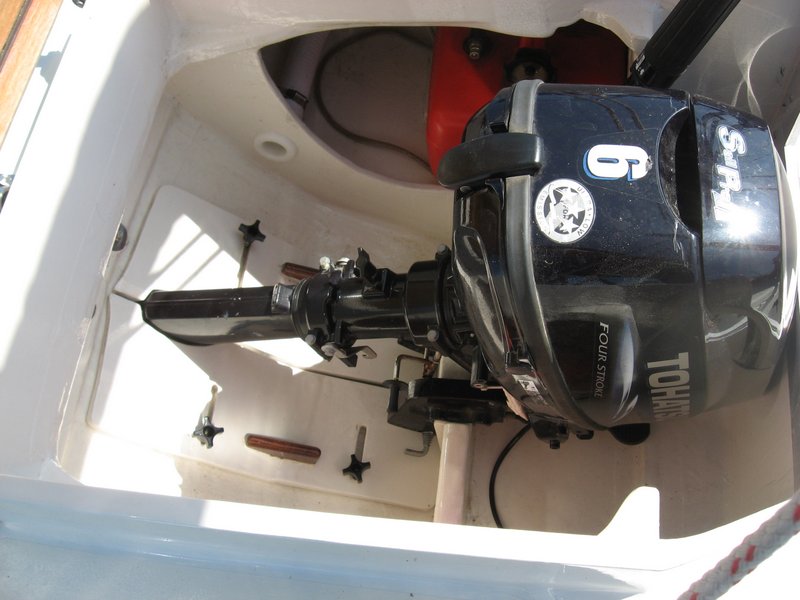

When the motor is tilted up for drag-free sailing the sliding cover boards can be closed to restrict waves from sloshing into the well locker.
The outboard well enclosure on the Triton is raised but does not intrude on the benches.
Early versions
It has been over 20 years since I built my first seagoing outboard well in a friend’s Taipan 28 sloop while we were in Trinidad. That outboard well consisted of a circular hole in the cockpit lazarette locker—above the water on the hull’s centerline—surrounded by a plywood and fiberglass box. When not being used, the 2-stroke 5 hp motor was lifted out of the box and stored on its side in a cockpit locker, and a sealed lid secured to the box to prevent water from entering the locker. On a combination cruise and delivery trip, my wife and I successfully sailed that Taipan on an expanded Atlantic circle that took us from the Caribbean to Bermuda, Azores, Cape Verde, and Brazil. Along the way, the outboard well proved to be a workable system and a huge improvement over the transom bracket. But I felt there had to be an easier method of dealing with the motor when going from motoring to sailing.


An early version non-tilting well built into a Taipan 28. This worked OK for small, lightweight two-stroke motors but proved impractical when we switched to larger four-strokes.
This fixed well version had a fairing plug bolted to the motor skeg to reduce turbulence and water entering the well box.
At first I only built fixed (non-tilting) wells and used 6 hp motors with a long shaft. Most motors in the 4-6 hp range are the same size and weight with different carburetors so it makes sense to use the 6. In the Tohatsu/Nissan range the 8 and 9.8 are the same physical size and the 9.9 is the same as a 15 hp. The Yamaha has 8 and 9.9 of the same size. For most boats the Tohatsu 9.8 or Yamaha 9.9 is the maximum practical size and should provide acceptable performance for boats up to around 32-foot or 6 tons. I see the latest 2019 version of the Yamaha 9.9 comes with a shorter tiller handle and looks like it has a smaller lower cowling that means a smaller hole is needed in the hull. Looking at the online specs and photos it seems the extra long shaft high-thrust version weighs 115 lbs and has too large a motor mount to fit the motor well space so you’ll need to confirm the sizes before making this conversion. These motors come in three standardized shaft lengths commonly referred to as 15-inch short shaft, 20-inch long shaft, and 25-inch extra-long shaft. Those numbers are based on an old American measuring system for motorboat transom height, which does not relate directly to a sailboat installation. In practice, on a sailboat you want to use the maximum 25-inch shaft whenever possible.
Those early fixed-mount motors I built, such as on the Taipan, meant that when not being used the motors had to be lifted out and stored in a cockpit locker or on a pushpit rail mount. If left in place they added drag while sailing and risked getting corroded or fouled with growth while sitting at anchor. With the smaller and lighter 2-stroke motors it was not too difficult to lift the motors out for storage or put them back in the well when it came time to enter port. But those 2-stroke motors burned gas mixed with oil and spewed some of that oil into the air and sea. They have also become less available in recent years as environmental protection restrictions have increased. When I switched to heavier 4-stroke motors, I found it impractical to lift them in and out of the locker when underway, and they needed to be stowed carefully to prevent crankcase oil from running to places where it shouldn’t. With the longer 25” shaft lengths needed to optimize performance it was even less feasible to remove them for storage.
Before I go into the details of why and how an outboard well conversion may make sense for a particular sailor and a particular boat, it’s worth noting how today’s cruising sailboat is typically used. On nearly all large modern sailboats and even those smaller ones that are big enough to be considered comfortable and safe for coastal cruising, the inboard diesel engine is the heart of the vessel. On many cruising boats today, the sails are used as auxiliary propulsion only when conditions are ideal or the owner feels inclined to the extra labor involved. That is backwards to how I have always sailed. A couple of generations ago “auxiliary-powered sailboat” meant that the vessel had an unreliable and often underpowered engine as a secondary means of propulsion. As small diesel engine design advanced, sailing skills retreated. Admittedly, a high percentage of boat owners are satisfied with their modern inboard engines and accept their total reliance on them. I am not trying to find fault or convert them. However, I know there are many sailors out there like myself who prefer a workable alternative to the inboard engine and want something that is less costly and complex and puts them closer to the raw elemental experience of passage making under sail.
Electric propulsion (EP) is becoming more popular among do-it-yourselfers who are fed up with internal combustion engines. They have either traded off significant power and range ability or had a big enough boat to carry a large diesel generator, which partially defeats the purpose of going electric. Typical EP systems have motors that require 48 volts, while the boat’s electrical accessories and wind and solar charging are 12 volts. This configuration requires the complications of vulnerable electronic step-up and step-down voltage convertors. Even so, I remain enamored by the possibilities of EP, particularly when more efficient batteries become as safe, reliable and affordable as todays AGM batteries, or in cases where range beyond a few hours is not required.
In 2023 I had the opportunity to install dual gas/electric outboard motors on a Cape Dory 27 and on a Cape Dory 36. The owners had the choice of using the electric outboards or when they required extra range and power, switching the the gas motors. Results can be seen in the links near the bottom of the page. Perhaps a retractable electric pod with remote speed control would be possible on some boats. But because of the increased cost of electric propulsion systems with limited range, large lithium battery banks and complex dual voltage charging systems the proven modern four-stroke outboard motor is the most practical solution for most sailors.
Outboard well design elements
Over the years my outboard well designs have greatly evolved. It became obvious to me that the ideal solution was a motor that stayed permanently in the well and tilted up through a narrow slot in the transom for storage. I built these improved versions on different models of sailboats including three Pearson Tritons, a Tripp 29, an Able 32, four Alberg 30s, a Cape Dory 27 and Cape Dory 36 among others. On most of those boats and on two of the Alberg 30s I installed a SailPro 6hp Tohatsu with 25” extra-long shaft and high-thrust prop because the motor was a good compromise between weight, physical dimensions, and thrust. Most sailors who are used to having more powerful engines consider a 6 hp motor on this size boat to be underpowered. It’s true you can’t motor into strong winds and waves with 6 hp, but many sailors understand the trade-offs of going to higher horsepower and choose not to. On the third Alberg 30 I converted, the owner was keen to have more power, and I was able to make some modifications to the design to fit a Nissan 9.8. The extra thrust it provided has proved sufficient for the owner’s needs. He also appreciates the electric start, which is not available and not needed on most smaller motors. On larger boats such as the Cape Dory 36 and Able 32 you might be tempted to use a 15 hp motor. You will need to take careful measurements to confirm the fit and I would not choose the electric tilt option because it adds too much bulk and weight.
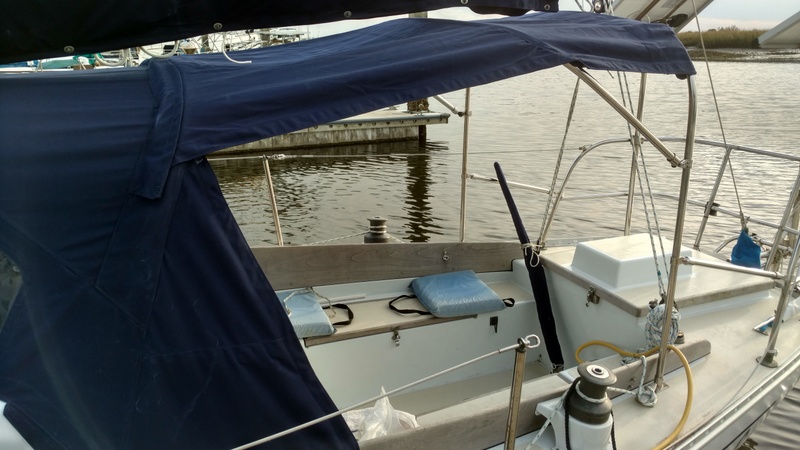
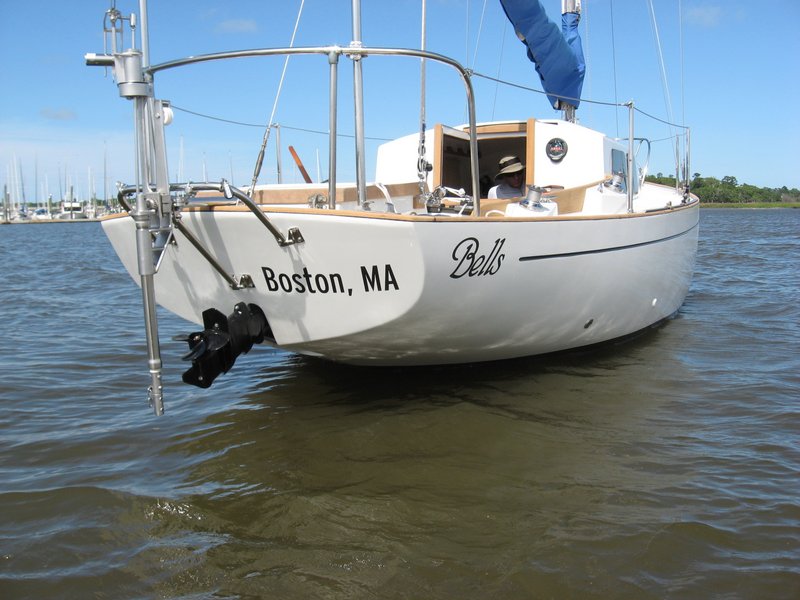
On an Alberg 30, which has a large lazarette locker and overhanging transom, the 6 or 9.8hp motors fit perfectly without the need to relocate the bulkhead.
With the motor raised for drag-free sailing or storage. If the prop ever gets fouled when motoring it’s a simple matter to tilt it up, reach over the transom, and clear it to get underway again.
Whereas the Alberg 30 has a generous lazarette of 34 inches fore and aft that can easily contain an enclosed outboard well, the Pearson Triton presented more of a challenge because of its smaller lazarette. My first outboard well in a Triton was an open-faced design, and the motor head overhung the rudder cap and tiller slightly when tilted up. Even though this design worked and was easy to construct, it did have a few drawbacks, such as the motor’s intrusion into the cockpit footwell when tilted as well as more noise and vibration to live with while seated in the cockpit. An open-faced well seemed less ideal than an enclosed well because the increased volume of the cockpit footwell combined with the open lazarette makes getting pooped by a rogue wave more of a concern. To mitigate that, the open well contains buoyancy chambers and it permits faster drainage of the footwell so I doubt it will ever be much of an issue. On later Tritons I pushed the motor aft another 1.5 inches and added structural stiffeners to what little remained of the aft deck and the transom above the motor shaft slot. This modification allowed me to enclose the front of the well while maintaining adequate structural integrity.
Because of their transom design, most boats are not suitable for an outboard well conversion. Good candidates are boats with overhanging transoms (stern counter) with 2–6 inches of clearance from where the motor skeg cutout will go in the hull and the resting waterline, and a keel-hung rudder that does not extend aft into the motor well zone. Another critical requirement is to have at least 30 inches between the transom where the motor shaft exits and the aft end of the tiller strap and rudderhead fitting. These requirements are met by some excellent classic boat designs that I have come to love. The Triton comes in at the minimum 30 inches. The Cape Dory 27 measures a slightly more manageable 31 inches. Larger boats such as the Alberg 30 and others already have ample clearance within the lazarette and do not require relocating the bulkhead. I’ve been in contact with owners of several other boats, including a Bristol 27, who have built similar tilt-up motor wells on their boats, based on my design plans. The concept and application of this modification have now been tested on many offshore passages including one of my Alberg 30 Voyager Editions that completed a circumnavigation in 2023, as well as ICW trips on several different boats. It is satisfying to know that several abandoned good old boats with blown inboard engines and other old-age issues have been resurrected and returned to service because of this cost-effective modification.
A functional outboard well design needs the following: sufficient prop depth to get a bite in moderate waves, a practical way to close off the hull and transom slot at sea, enough clearance from the hull cutout to the waterline to reduce back-flooding, and the largest possible buoyancy chambers built in to the lower portions of the well. Some builders may have produced a sensible, offshore-suitable boat with this type of enclosed tilt-up outboard well, but I am unaware of them.
Boats with fixed motor wells as options, such as the Cape Dory 25 and 26, Pearson Ariel 26, and Bristol 26 and 27, for example, were popular daysailers but were not attractive to most potential small boat voyagers partly because the motors are fixed in place, causing drag turbulence under sail, fouling, and corrosion problems. In my view, those designs are impractical, except perhaps if the boats are kept on freshwater lakes. If a slot is cut in the hull to allow the motor to tilt up and forward, and some other improved design details, most problems associated with old-style fixed outboard wells are avoided. An added benefit to having the motor shaft pivot up through a slot in the transom is that the hull shaft hole and transom slot can be surprisingly narrow and inconspicuous. The hull hole does not need to be as wide as the prop because it is taken off the motor with one nut, the motor placed in the well, tilted forward, and then the prop easily reinstalled by leaning over the transom. To remove the motor, the prop is pulled first.
In 2014, I figured out how to enclose a 6 hp Tohatsu SailPro on Atom by moving the center of the original lazarette bulkhead forward. It was considerably more work than an open well design, and it required pushing the motor mount position further aft and 1” higher than on earlier Triton conversions, resulting in a higher and more unsightly raised lid. Even so, I’m happy with the result, and the motor box lid serves as a good elevated seat or table. The motor pushes the Triton at 5.8 knots at full throttle in calm seas and is surprisingly good when punching into a light headwind and chop.
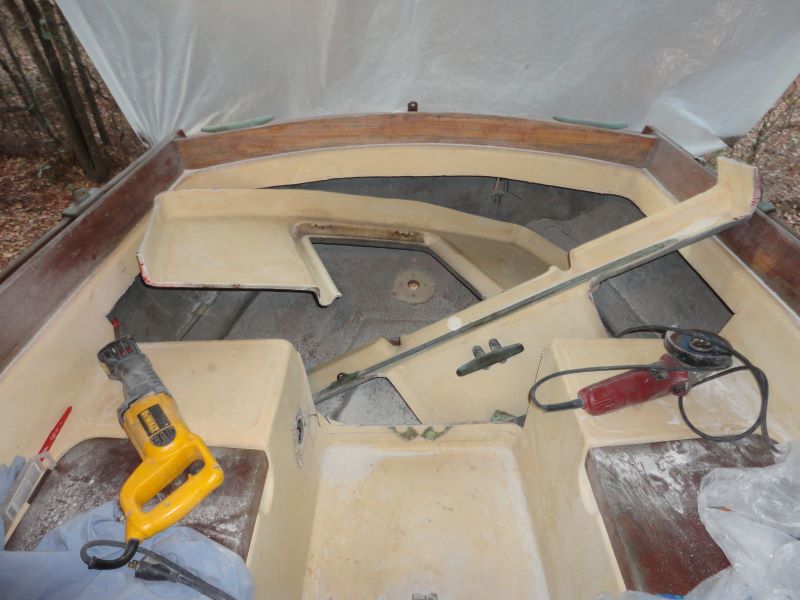

Fitting an outboard well to a Tripp 29 required modifying the aft cockpit by cutting out the lazarette locker.
The finished Tripp 29 outboard well.
Addressing the cons
Although my outboard well conversions have exceeded my initial expectations, a combination of factors have prevented outboard wells from becoming more popular. Market forces value push-button technology over age-old sailing skills. We are more inclined to power through nature’s elements than to bend to their will. The old boat restorationists are likely to cast a condemning eye on any classic boat that has had major modifications done to it, even if their authentic restorations of small to midsized production sailboats does nothing to make that boat more cruiser friendly or seaworthy. Others who have experienced the limitations of transom mounted motors or old-style fixed outboard wells as installed on small production sailboats have wrongly concluded that a better design with more care to functionality would have the same problems. Experienced sailors are by definition largely conservative and suspicious when it comes to altering their boats in a significant way. That is as it should be but if, like me, you have the sailing experience to make your own judgements on what is practical for your situation, you won’t feel constrained by the misguided opinions of those with differing views.
On many boats you have no choice other than to install a transom bracket. The disadvantages are that it is awkward to reach the shifter, throttle, and to turn it for side thrust to maneuver in a marina, it’s exposed to theft and is ugly, is more prone to getting the motor head dunked or the prop sucking air in choppy water, and the weight is farther aft than is ideal for best sailing performance. Also, if you have a centerline windvane then the motor needs to be on the corner of the transom, further degrading performance when the boat rolls or when it heels during motorsailing. On the other hand a transom bracket is a more simple installation and some boats transom design are just not suitable for an outboard well.
I have had one failed outboard well design that others can learn from. In 2008, on a friend’s Alberg 35 we replaced his very ill diesel that had been dripping oil into his bilge for years and driving him nuts with breakdowns. He did not want the diesel rebuilt or replaced: he wanted it gone forever. Because the Alberg 35 had a long and high stern counter, we felt it would be too difficult to get the motor far enough aft where the shaft could penetrate the transom when tilted up, but still be far enough forward to keep the prop in the water when in the motoring position. Our compromise experiment was to use a fixed, open-faced well kept as far forward as possible but with a 20” shaft Mercury 9.9 that could be hoisted out of the well with a tackle and laid on its side in the lazarette for storage. The result was an awkward arrangement and the shaft length proved too short to keep the prop from sucking air in anything but calm waters. The lesson there was that a fixed well for anything larger than 6 hp is unworkable and that the 25-inch extra-long shaft is the best choice. If I were to do it again I would insist on the tilt-up design and 25-inch shaft.
One of the disadvantages of outboard motors is that they are not designed for extreme long-term use, at least compared with the diesel engine. Experts have pointed out that outboard motors wear out sooner and require different, although simpler maintenance. Seawater does splash into the well in rough weather and can cause corrosion if the motor is not rinsed and lubricated occasionally. I never tried, but you probably do not want to depend on frequently running an outboard motor 24 hours a day. When I have had problems with outboards it was typically bad spark plugs or a clogged carburetor, both of which are easy to troubleshoot and fix. I now carry an entire spare carburetor to swap out in minutes if the jets become clogged. I can then go on my way and thoroughly clean out the clogged carb at my leisure. In the worst case of an unrepairable breakdown, you just buy another new or used motor, drop it in, and off you go.
The alternators available on outboard motors have very limited output so you must rely on solar or wind charging systems when away from marina shore power. Another limitation is that reverse thrust is limited on most 6 hp motor models perhaps because of the exhaust running out the center of the prop. You may have to wait for slack tide to exit your marina slip if the current is coming from astern.
Other often heard arguments are that diesel is much less explosive than gas and is more efficient for long range motoring. That is true. However, with my outboard well conversions the two portable gas tanks are stored in the vented lazarette next to the motor and sealed from the rest of the boat. Any extra gas cans carried to extend range are stored in the cockpit side lockers that are also sealed from the interior and bilge, making fire risk minimal. Typically, on a 30-foot boat you can expect roughly 10 miles per gallon with a 6–9.8 hp motor in calm conditions at three-quarters throttle. Carrying 15 gallons of gas will get you 150 miles, which is not much of a constraint for most sailors who know how to use winds and currents to their advantage.
If brute force motoring in rough seas is your primary concern, then the inboard diesel is the clear winner. In practice I have tested these motor installations in short choppy waves at an ocean inlet with up to 3-knot current against 15 knots of wind and had no problem with the prop coming out of the water. Beyond that, you may need to wait for a change in wind or tide. Most of today’s motors have an Over Rev RPM Limiter to prevent motor damage from a racing prop. I place the motors as far forward and low as possible and now only use extra-long shaft models that rarely have a problem of the prop sucking air. Even though they work much better than putting them farther aft on a transom bracket, due to the possibility of the prop coming out of the water and the relative low horsepower I do not attempt to motor in extreme wave conditions. Power, range, and keeping the prop always in the water are clear advantages of inboard diesels.
While it is possible to have stern-mounted dinghy davits that will clear the outboard motor in its tilt-up position, I don’t recommend them if there is a chance you will install windvane self-steering one day. If you already have a windvane installed, you may need to extend the mounting brackets so they do not interfere with the motor shaft. In addition, a swim ladder built into the pushpit will likely need to be relocated.
Another thing to consider is that if retaining the highest resale value of your boat is a primary concern then understand that removing the stock inboard engine will shrink the pool of prospective buyers and probably lower the boat’s resale value. On the other hand, a properly designed and built outboard well modification in conjunction with other mods and upgrades, were responsible for one of the Alberg 30s I refit in 2014 selling for a record price two years later to a sailor who appreciated the conversion.
This type of conversion may be beyond your current skills to tackle yourself. However, many people have obtained the dimensioned sketches, instructions and full size paper patterns from me in order to make the project go faster and with less errors and have either done the work themselves or hired a local boat repair person to build it for them. If you need the patterns for either the Pearson Triton or Alberg 30 you can let me know through this site’s Contact button.
The benefits
If you removed the inboard engine and all its components and laid them out on the ground you might be shocked at the amount of related gear that ran through the center of your boat and the valuable space it all consumed. The ubiquitous inboard engine’s many interconnected life support systems include cooling water plumbing and thru-hull fittings; separate engine starting battery and dual charging electronics; gauges, transmission and linkages; fuel tanks, lines, and filters that often clog or leak; a shaft penetrating the hull in an often hard to access place; and a propeller that is inaccessible and is prone to damage or fouling. Then there are all the specialized tools, maintenance materials, manuals and how-to books, and recommended spare parts to carry, particularly if you stray far from repair facilities. There is also the risk that the engine cooling water system or prop shaft stuffing box could fail one day and sink your boat.
The advantages of a properly designed tilt-up outboard well over inboards on a suitable boat include the following:
1. Less cost up front and for future maintenance.
2. Less weight and wasted space.
3. Reduced complexity, which makes for easier future motor replacement or repairs. You can take the motor to the repair shop instead of bringing a mechanic and all his tools to the boat.
4. There is no fixed prop to snag fish traps and nets under sail.
5. If the prop ever gets fouled or damaged you just tilt it up and clear it or replace it by reaching over the transom.
6. Sailing performance is noticeably improved by less drag and turbulence once you remove the inboard’s fixed prop and seal off the prop aperture between keel and rudder. The rudder will also become more efficient.
7. You have the ability to swivel the motor for side thrust when entering a tight marina slip.
8. An outboard well puts an end to inevitable diesel fuel and oil spilled into the bilge and their odors.
9. The self-contained outboard motor reduces holes underwater—no engine cooling water seacock and plumbing or prop shaft in a leaky stuffing box.
10. Because you no longer need to access a diesel exhaust and prop shaft and all the rest, you can now seal off all the cockpit lockers from the bilge, giving you the added safety of collision bulkheads and less chance of flooding.
11. There is no need for a separate engine starting battery and charging circuit. If you do want electric start, that is available on the 9.8 hp models. With pull start, a dead battery will not prevent you from starting the engine.
12. The motor does not radiate unwanted heat into the boat all night when you try to sleep in the summer or in the tropics after motoring.
13. A smaller motor has a smaller environmental impact.
14. Another benefit I recently discovered to small outboards is that if you upgrade from lead acid batteries to lithium type, it is much simpler and less costly because you don’t need a special engine starting bank, new alternator and the charging equipment modifications required for diesel alternators. The limited intermittent charging current on a small outboard alternator is not a problem for a normal sized lithium bank and you can manually turn off the switch if needed.
There are also intangible benefits to downsizing to a small self-contained motor located within an outboard well. The boat size restriction to still have adequate thrust with an outboard motor means you are compelled to have a modest sized boat instead of being lured into a bigger boat that might prove more work and expense to maintain than you want. The best boat is the smallest boat that will do what’s required of it. The more limited range and thrust of a small outboard teaches you to become a better sailor. You will find that as your sailing skills and experience in passage planning increase, there will come a corresponding decrease in the horsepower you need. After weighing the relative merits of outboards and diesels, each sailor chooses a system based his or her own needs.
Most cruising sailors are not going to switch from a diesel inboard to an outboard well conversion. However, if you don’t have unrealistic expectations and are looking for an alternative way to bring back to life a suitable older classic sailboat, the improved outboard well is worth considering. Perhaps more of those neglected but worthy old boats languishing in forgotten corners of boatyards because they have a blown or ancient inboard engine will now be rescued from the scrap yard.

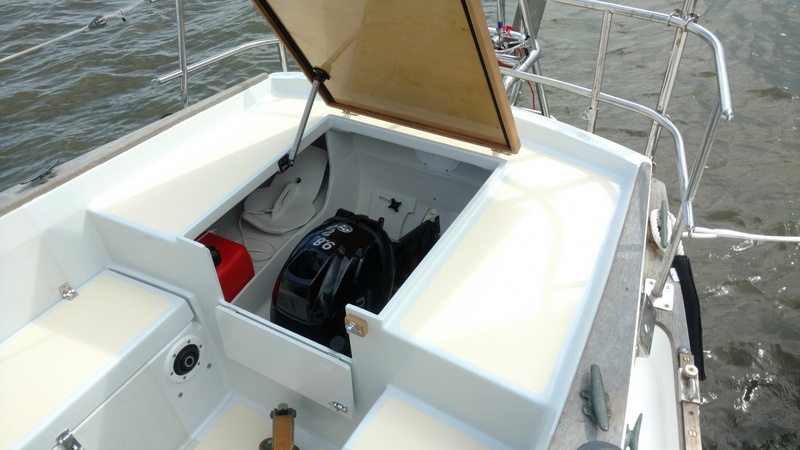
This Able 32 had an open-faced outboard well added before it was brought to us. We rebuilt the well in an enclosed version.
The enclosed well we built for a 9.8hp motor in this Able 32.
Below is a list of boats that I have either confirmed to have useable lazarette lockers and transom overhangs suitable for a tilt-up outboard well or look like they will be suitable. There are many other boats such as the Taipan 28 and Cape Dory 25 and 26 that have less than 30 inches between rudder/tiller strap assembly and transom that are a bit too tight for a tilt-up well but can accommodate a fixed well. Or it may be possible to cut out and rebuild a portion of the center transom on boats that are lacking a 30-inch long lazarette.
1. Alberg 30 – Confirmed both 6 and 9.8 hp installed. This boat has the ideal combination of adequate lazarette size and overhang of transom on a boat that is large enough to be comfortable and capable offshore and small enough to be driven near hull speed with a small outboard. Contact me if you need full-size paper patterns and instructions for DIY.
Video of Alberg 30 9.8 hp outboard well construction
2. Pearson Triton 28 – Confirmed 6 hp installed. This boat requires the aft cockpit bulkhead to be modified, which makes the motor well more boxy in appearance and the job more complicated than on an Alberg 30. Full-size paper patterns and instructions available for DIY.
Video of Triton 6 hp outboard well construction
Video of Triton 6 hp with a simpler open face design
3. Tripp 29 – Confirmed 6 hp installed and it looks like the 9.8 would also fit. This boat required extensive cockpit modifications but the results are excellent.
Video of Tripp 6 hp outboard well construction
4. Able 32 – Confirmed 9.8 hp installed. This boat required the most extensive modifications but had a good result.
Video of Able 32 9.8 hp outboard well construction
5. Cape Dory 27 – Confirmed 6 hp Tohatsu installed. We also fit an Epropulsion Navy EVO 3.0 electric outboard to this boat. Video of construction
6. Cape Dory 36 – Confirmed 9.8 hp Tohatsu installed. We also fit an Epropulsion Navy EVO 6.0 electric outboard to this boat. Video of outboard well construction
Video of Cape Dory 36 outboard well sea trials
7. Bristol 27 – At least one tilt-up well for 6 hp has been built.
8. Pearson Vanguard 32 – At least one tilt-up well for 6 hp has been built.
The following are unconfirmed but appear to be suitable:
1. Rhodes Meridian 25 – Some of these came from the factory with an outboard well.
2. Allied Luders 33
3. Bristol 32
4. Seasprite 28/29
5. Rhodes Chesapeake 32
6. Rhodes Swiftsure 33
7. Lello 34
8. Cape Dory 30 and 31
9. Cheoy Lee Clipper 33
10. Also, the Pearson 365 has been done. Here is an article on a Hybrid Gas Outboard Well / Electric Inboard in that boat.
I’m sure there are other models out there that can accommodate an outboard well so please contact me if you have additions for this list.
Part two – Adding a Tilt-up 9.8-hp Outboard Well to an Alberg 30
